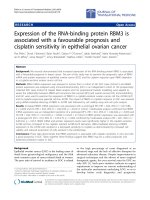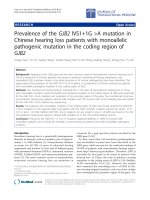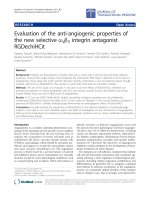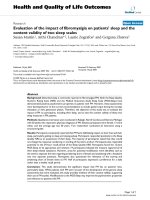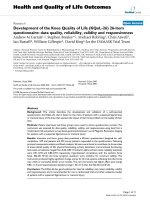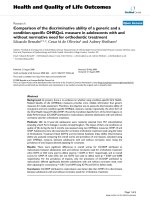báo cáo hóa học:" Rupture of the meniscofibular ligament Case report" docx
Bạn đang xem bản rút gọn của tài liệu. Xem và tải ngay bản đầy đủ của tài liệu tại đây (2.28 MB, 3 trang )
Unay et al. Journal of Orthopaedic Surgery and Research 2010, 5:35
/>Open Access
CASE REPORT
BioMed Central
© 2010 Unay et al; licensee BioMed Central Ltd. This is an Open Access article distributed under the terms of the Creative Commons
Attribution License ( which permits unrestricted use, distribution, and reproduction in
any medium, provided the original work is properly cited.
Case report
Rupture of the meniscofibular ligament
Koray Unay*, Korhan Ozkan, Irfan Esenkaya, Oguz Poyanli and Kaya Akan
Abstract
The meniscofibular ligament is an anatomically defined ligament of the knee in humans. However, there are no data
regarding the prognosis following injury to this ligament. Our case was a 42-year-old man who presented at our clinic
with pain of the lateral side of his left knee. MRI of his left knee revealed the rupture of the meniscofibular ligament. The
mechanism of injury was consistent with anatomical and mechanical studies of the meniscofibular ligament. The
patient was treated conservatively for 1 year, but his pain did not resolve completely. A case series of patients with the
same injury is required to establish an effective treatment for this rare injury.
Introduction
The lateral collateral ligament of the knee consists of
superficial, intermediate, and deep layers, which contain
defined ligaments and pericapsular tissues. The menisco-
fibular ligament is an anatomically defined ligament of
the knee in humans [1-3]. However, there are no data
regarding injury to this ligament and the prognosis. Boz-
kurt et al. confirmed the presence of this ligament in all
the subjects examined in their study, demonstrating
increased tension of this ligament during dorsiflexion of
the ankle and describing its protective function against
varus forces to the knee and external rotation forces to
the leg [1]. Furthermore, Bozkurt et al. emphasized the
need for biomechanical, radiological, and clinical studies
of the meniscofibular ligament [1].
Although anatomical and mechanical characteristics of
the meniscofibular ligament have been described, to the
best of our knowledge, no case of injury to this ligament
has been reported in the literature. Here, we describe a
case of meniscofibular ligament injury and present our
preferred treatment method and its outcome.
Case Presentation
A 42-year-old male taxi-driver presented to our clinic
with pain of the lateral side of his left knee. He had no his-
tory of trauma and did not report any rheumatological
disease or previous knee surgery in his medical history.
He stated that the pain was usually more intense when he
waited in the car for a customer. His position in the car
seat while waiting for a customer is depicted in Figure 1.
This position forced his ankle into dorsiflexion, his knee
into varus, and his tibia into external rotation.
Tenderness at the head of the fibula and at the periph-
ery of the lateral meniscus during palpation was the only
positive finding during physical examination of the left
knee. Tests for postero-lateral knee instability were nega-
tive. There was no pain or limp during walking. Pain
occurred only during squatting and kneeling. Lower
extremity neurological examination was intact. Peroneal
nerve entrapment and radiculopathy-discopathy was not
found. Antero-posterior radiography of his left knee
showed no abnormalities. MRI of the knee (Figure 2 &3)
revealed the rupture of the meniscofibular ligament. No
other pathology was detected by MRI. The inclination of
the proximal fibular joint was measured as 35 degrees; as
the angle was greater than 20 degrees, it was classified as
an oblique proximal fibula [3].
Bed rest was recommended for the first 10 days, with
no weight-bearing and the use of two crutches. The knee
was stabilized with a knee brace for 6 weeks, and a non-
steroidal anti-inflammatory drug, diclofenac sodium 1 ×
75 mg/day, was used for 3 weeks. The patient was allowed
to return to his job after 3 weeks. He was advised to not
sit for a long time in the above-mentioned position in the
car seat. His pain gradually declined but persisted for 4
months. He was followed up for 1 year. At his last visit,
the pain was considerably reduced because he had not sat
in the above-mentioned position, but the pain had not
subsided completely.
* Correspondence:
1
Department of Orthopaedic and Traumatology, Goztepe Research and
T
raining Hospital, Istanbul, Turkey
Full list of author information is available at the end of the article
Unay et al. Journal of Orthopaedic Surgery and Research 2010, 5:35
/>Page 2 of 3
Discussion
In an anatomical study, Bozkurt et al. described the posi-
tion at which the meniscofibular ligament is in tension
[1]. According to its anatomical structure, the proximal
fibula is classified as oblique when the inclination of the
joint is greater than 20 degrees or horizontal when the
inclination of the joint is less than 20 degrees [3]. A hori-
zontal proximal fibula allows a wider range of rotation
[1,3]. Bozkurt et al. demonstrated that the meniscofibular
ligament is thicker in subjects with a horizontal proximal
fibula and rather slender in those with an oblique proxi-
mal fibula. Dorsiflexion of the ankle has been shown to
create tension in the meniscofibular ligament. A protec-
tive function against varus and external rotation forces to
the knee has been described for the meniscofibular liga-
ment [1]. The sitting position described by the patient
exactly matches the position that creates meniscofibular
ligament tension (Figure 1). We believe that repetitive
minimal stretching was responsible for the ligament rup-
ture.
The mechanical significance of the ligament may be
limited to its support of the lateral group of ligaments,
but the meniscofibular ligament may also have a role in
posterolateral corner and lateral meniscus injuries.
Although the pain in the present case was considerably
reduced after treatment, it had not subsided completely
at the end of 1 year. This implies that the rupture of this
ligament does not have a simple clinical prognosis.
We have presented the treatment and clinical prognosis
of a patient with rupture of the meniscofibular ligament.
This is the first time that this injury is reported. The
mechanism of injury in our patient was consistent with
previous mechanical and anatomical studies of this liga-
ment. This case was the first clinical description suggest-
ing a mechanical role for the meniscofibular ligament.
Pain was considerably reduced after 1 year of conserva-
tive treatment but had not completely resolved. A case
series of patients with the same injury is required to
define the prognosis of this injury.
List of abbreviations
MRI: Magnetic resonance imaging.
Figure 1 Sitting position of the patient in the car.
Figure 2 Coronal section of MRI of the left knee. Arrow: ruptured
meniscofibular ligament.
Figure 3 Sagittal section of MRI of the left knee. Arrow: ruptured
meniscofibular ligament.
Unay et al. Journal of Orthopaedic Surgery and Research 2010, 5:35
/>Page 3 of 3
Consent
Written informed consent was obtained from the patient
for publication of this case report and accompanying
images. A copy of the written consent is available for
review by the Editor-in-Chief of this journal.
Competing interests
The authors declare that they have no competing interests.
Authors' contributions
KU conceived the idea and co-wrote the paper; KO and IE writing and aided in
the editing of the manuscript; OP colleted the references and analyzed them
and KA design the manuscript and edited the manuscript. All authors read and
approved the final manuscript.
Author Details
Department of Orthopaedic and Traumatology, Goztepe Research and
Training Hospital, Istanbul, Turkey
References
1. Bozkurt M, Elhan A, Tekdemir I, Tönük E: An anatomical study of the
meniscofibular ligament. Knee Surg Sports Traumatol Arthrosc 2004,
12:429-433.
2. Ogden JA: The anatomy and function of the proximal tibiofibular joint.
Clin Orthop Relat Res 1974, 101:186-191.
3. Obaid H, Gartner L, Haydar AA, Briggs TW, Saifuddin A: The
meniscofibular ligament: An MRI study. Eur J Radiol 2008. doi:10.1016/
j.ejrad.2008.09.026
doi: 10.1186/1749-799X-5-35
Cite this article as: Unay et al., Rupture of the meniscofibular ligament Jour-
nal of Orthopaedic Surgery and Research 2010, 5:35
Received: 10 October 2009 Accepted: 18 May 2010
Published: 18 May 2010
This article is available from : http://www.j osr-online.com/ content/5/1/35© 2010 Unay et al; licensee BioMed Central Ltd. This is an Open Access article distributed under the terms of the Creative Commons Attribution License ( ), which permits unrestricted use, distribution, and reproduction in any medium, provided the original work is properly cited.Journal of Orthopaedic Surgery and Research 2010, 5:35




